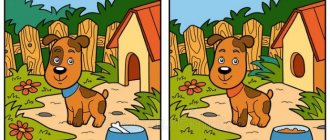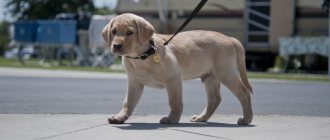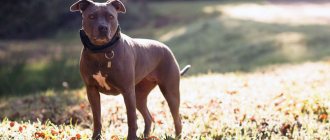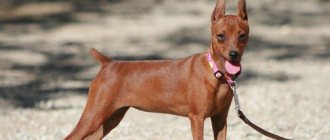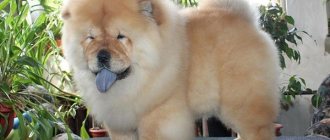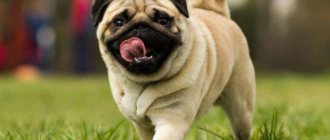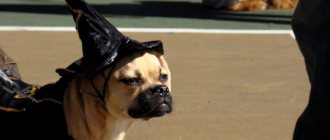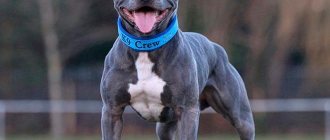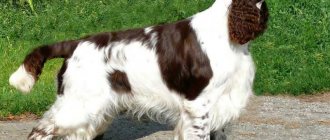Getting to know your new home
Moving to a new place of residence is always stressful for a small dog - after all, first of all, it means separation from its mother and its usual habitat.
Remember! The best time to take a puppy to a new home is 3 months. At this time, early socialization skills have already been formed, and moving will not be a problem.
If the puppy appeared in the house at an earlier age, you will have to “replace” his mother for a while and spend as much time with him as necessary until he stops being sad.
How to make your move comfortable?
To ensure that acquaintance with your new home does not cause problems, you should adhere to the following rules:
- Plan for the puppy to arrive in the morning so that he has the opportunity to adapt to new conditions during the day: in this case, the first night in a new place will be calmer.
- Take his toys or bedding from the old house. Any thing that smells like mother or familiar surroundings will help make separation easier.
- Spend enough time with your dog without letting him get sad. Games are a good help: after jumping to his heart's content, the puppy will sleep most of the day.
- At first (several days), it is better to come to terms with the thought of sleepless nights. Puppies often cry when they miss their mother and littermates. Let the baby be close to the owner, but you should not take him into your bed: firstly, it is not safe, and secondly, it is a bad habit that will later be difficult to get rid of.
- It’s right if someone can stay with the puppy for a few days: this is not done to be with him around the clock, but to help with adaptation.
Development of the apartment
There should be no objects in the apartment that could harm the dog: wires stretched across the floor, household chemicals in the public domain, as well as those things whose damage is undesirable.
Puppies, like children, are very curious. They spoil things not intentionally, but with the goal of understanding the world. So that there are no reasons for pointless anger, it is correct to remove carpets from the floor: puppies, learning to go to the toilet outside, will leave puddles and heaps at home for some time.
The puppy must explore all the rooms in the apartment, and the owner’s further task is to show which areas are available for stay and which are not.
It is worth being firm from the very beginning: if you do not plan for the dog to go into the bedroom or kitchen, it is necessary to train the puppy from childhood. Also, the puppy is immediately given a place for the toilet if it is planned for it to be stationary (for decorative breeds of dogs).
Getting to know a private house
If a dog is taken into a private home and will have to live on the street, a place for the puppy must be prepared in advance: an enclosure or kennel with everything necessary is equipped.
The puppy needs to be walked around the area so that he understands that this is his territory and becomes familiar with it. Subsequently, the dog that was taken for protection is put on a leash, and if the dog is an enclosure dog and lives on the territory, it is locked in the enclosure for the night so that it gets used to the place of rest and food.
All dangerous objects are also carefully removed from the territory where the puppy will be.
Ears
Care for your pet's ears regularly. Veterinary experts do not recommend using cotton swabs for cleaning, as they can damage your pet’s inner ear and form a cerumen plug. Much more effective and safer are special lotions that help remove dirt. A few drops are injected into the animal's ear canal, then the dog shakes its head, and all the dirt accumulated inside ends up on the inside of the ear. All you have to do is wipe it with a napkin. If your puppy constantly shakes his head, scratches his ears, and you see a large amount of dirt inside the sink, you should contact a veterinarian.
Eating behavior: how and what to feed a puppy
From the first day, the puppy should have its own diet, including a certain number of feedings of the same type of food. There are several ways to feed pets, and they all have the right to exist: how and what to feed a pet depends only on personal beliefs and the owner’s availability of free time.
Industrially produced super-premium and holistic foods have now proven themselves very well. Dry food is convenient: feeding standards are indicated on each pack, the products themselves are produced taking into account the needs of dogs of different breeds and their predispositions to diseases. In the industrial food category there are also canned foods.
If a natural type of feeding is chosen, there should always be fresh meat in the house, as well as vegetables, cereals, dairy products and vitamins. This is a more labor-intensive way, but it has an undoubted advantage: it is always clear what the dog ate.
Whatever feeding principle is chosen, it is important to understand: the dog is a carnivore, and the basis of its diet is meat products.
It is preferable to leave the puppy the type of food that he or his mother had before the change of residence.
Life without a mother: nutrition from birth to 4 months
From birth until the moment when the puppies begin to go to their new homes, they remain near their mother, and, despite the introduction of complementary foods, continue to drink her milk if the opportunity arises.
Milk is an important supplier of antibodies to the body of babies, whose immune system is too weak and is constantly exposed to pathogenic microflora. Without receiving mother's milk in the first days after birth, puppies are at high risk of death.
A puppy does not always end up in caring hands from a “prosperous family.” Often babies are picked up on the street, and they also need help if the bitch dies or lacks milk. One way or another, newborn babies need to be raised to their feet.
How to feed a newborn puppy
Immediately after birth, puppies are absolutely helpless without their mother. Their vision and hearing are not developed, they do not control their body temperature and do not know how to defecate on their own. The only thing they have is a sense of smell, thanks to which they know how to find milk in their nipples.
Feeding a puppy under 2-3 weeks of age is not easy. After all, the task is not only for him to eat: a person has to replace his mother and fulfill all her duties in order to save the baby’s life. But it is still possible.
Hygiene and grooming
Concepts such as hygiene and grooming mean caring for the puppy’s skin, coat, teeth, eyes, ears, as well as trimming its nails. Some procedures are performed daily, and such as haircut or trimming (care of the coat of a certain category of dog breeds) are done periodically, depending on the goals.
Hygienic procedures for a puppy are mandatory and are carried out from the moment the pet arrives in the house. This is both a path to health and an indicator of the owner’s care, not to mention the cleanliness of the apartment and the beauty of the dog.
Not all care measures are pleasant for the puppy, and if you do not care for him daily according to all the rules, cultivating the habit of patience, coexistence with the dog may become problematic in the future.
Regular puppy care measures include:
- Cleaning the ears: for this there are sanitary napkins with special impregnation.
- Eye care, especially in dog breeds with a predisposition to discharge.
- Trim the nails (there is a nail clipper for this) as they grow - approximately once every two weeks.
- Teeth cleaning. There are toothbrushes and toothpastes designed for dogs. Teaching your puppy to brush his teeth is beneficial: it is an act of trust in which the dog will always obediently open his mouth under certain circumstances (for example, when checking his bite at a show).
- Combing. Pets of different breeds have their own coat structure, for which special combs are provided.
Puppies of different breeds have their own characteristics. Some animals need to be bathed frequently, for others a grooming once a month is routine, while others only need a bath twice a year. In any case, you need to groom the puppy as often as the breed dictates so that he gets used to it.
Many dogs participate in exhibitions, and then owners turn to the services of professional groomers. The dog will have to spend several hours in the beauty salon, patiently waiting for the work to finish, and the owner will make the pet’s life much easier by teaching him from childhood to the procedures of washing, combing, drying and cutting.
Care
- Try to walk your puppy as often as possible. Let him get used to relieving himself on the street. It is clear that only after 6 months. he will be able to hold back longer, but get him used to it gradually. After walking, if it has rained, wipe your baby’s paws and belly with a damp cloth. Comb everything with a thick iron comb. Are there ticks or fleas?
- Once a week, wipe the baby’s ears with cotton swabs, and if their eyes are watery, rinse them with strong tea tincture. Use special drops to remove the infection. There should be no mucus from the nose or, especially, from the mouth. Did you notice? Treat it yourself or take it to a veterinarian for a consultation.
- This is how you bathe a puppy: put it in a basin and pour water over the withers and back. Do not wet your eyes and ears. Then lather with dog shampoo, lather and rinse. Do everything smoothly, affectionately telling him how smart he is, and don’t put him directly under the water stream so that he doesn’t get scared. Then dry with a towel. If it's cold, dry it with a hairdryer. In the summer it will dry out anyway. The puppy needs to brush its teeth with a special toothpaste 3 or 4 times every 7 days. Get 1st and 2nd vaccinations on time.
Aspects of education
Sometimes, with the best of intentions, new owners do too much to relieve the puppy from the stress of separation from its mother. This applies to being with the baby every minute, feeding in places not intended for eating, constantly being carried in arms and other things.
You should understand: the puppy will grow up, but the habits will remain.
The older the dog gets, the less affection his pranks cause, and over time, the dog still begins to instill good manners. Late socialization and learning the rules of behavior in the house are painful for animals and traumatic for the psyche.
Prioritization or who is boss in the house
In order for the puppy to learn from the first days the arrangements in the “pack”, where the leader will be a person, you need to adhere to some rules:
- Both the dog and the owner have the right to privacy. You cannot spend all your free time with the puppy - the puppy must be able to occupy itself. After playing with your pet, you should leave him alone and go about your business. You can defiantly ignore him for a while: the baby will calm down and stop bothering you.
- You need to teach your dog to stay home alone. You need to do this from the first day, going out the door for a few minutes. It is important that the puppy sees this happening and does not sleep during this time. Over time, the “care” intervals are increased, but no more than an hour in the first few days. During the period when the baby is left alone, he should be well-fed and play enough.
- From the first days, the puppy needs to arrange a place to rest and eat: he must learn to understand that the apartment is divided into certain zones, each with its own functionality. If the feeding place is chosen in the kitchen, it is wrong to expect that the dog will not subsequently go there whenever he wants.
- The dog eats after the owner. This is a very important rule, which subsequently eliminates many behavior problems, especially in “serious” dog breeds. The dog must see that the person (leader) is eating. This is the order of the pack among wild relatives, and domestic animals are no different genetically from them.
- The owner goes up the doors, openings, and stairs first. The puppy will not learn this rule from the first day, but from the moment training begins, you need to remember it, since it is included in the list of priorities.
Such aspects of education do not violate the norms of morality and morality, and the dog will not love its owner less if it learns them. Raising a puppy does not mean its humiliation or infringement of the animal's rights. It is aimed at comfortable coexistence between humans and dogs in society and is designed to ensure, in particular, the safety of people living with the pet.
Place training
Your puppy should have a place where he can feel safe and rest without worrying about someone stepping on him or kicking him out of the way. As a rule, dogs like special beds that are sold in pet stores, but you can also easily design them yourself. Small breeds of dogs are provided with houses, while very large dogs often do without bedding at all. The lounger is arranged in a non-accessible area of the apartment, away from drafts.
In addition to the rest function, the place for the dog has another purpose: it is a certain point where the puppy can be sent if he is in the way or gets naughty. Determining a place for a dog is very important: it increases self-esteem, since a smart owner respects not only his freedom, but also his dog’s personal space.
Teaching a puppy the “place” command is not difficult. At the moment when he has had enough of playing and has practically fallen asleep, he needs to be taken to the mat and told “place!” The command is also repeated during the puppy’s attempts to explore the bed. Fixing the location with a voice will be imprinted in the dog’s memory over time. You can accustom him to his place from 2 months.
Important: it is wrong to try to strengthen the team with food by placing treats on the bedding. The dog is not fed where it sleeps; conflicting commands can confuse the pet.
Toys
Like all children, puppies should have their own toys. Their presence is very significant:
- They protect things and objects in the apartment from destruction, because teething requires a product that can relieve the itching, and often without the opportunity to chew a tasty toy, puppies spoil clothes and furniture.
- Toys help brighten up the puppy's lonely hours when the owners are not at home.
- This is a great way to keep your pet in good physical shape and a means of training the mind: many modern toys are created specifically for this purpose.
Bad habits of puppies and ways to eliminate them
There are a lot of options for unwanted behavior in puppies. Let's look at the three most common of them.
1) Beggar dog. This puppy always hangs around the dinner table when the owners are getting ready to eat. The baby whines, looks pitifully straight into the eyes and tries in every possible way to get a tasty morsel. This behavior is formed after the dog has been treated to food from the owner’s table at least once. Feed your pet before you sit down for lunch or dinner, never indulge his whims and do not give him anything from the table.
2) Beaver dog. Sometimes puppies consider table legs, armrests of sofas and chairs, and wires to be edible. The habit of chewing furniture and other objects not only harms the owner’s belongings, but can also be dangerous for the pet itself. Try treating your puppy's favorite places with a special spray. You can buy this repellent at any pet store.
3) Food from the ground outside tastes better! Often, puppy owners are faced with the problem of their pet picking up food while walking outside. This behavior can pose a threat to the health and life of the dog. During a walk, the dog should be muzzled and on a leash, this will protect it from dangerous “treats”. Also teach your pet the “Fu” command.
